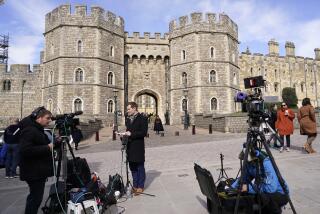Some Lament British Royalty’s ‘Common’ Ways : Will the Trend Toward Marrying Down Take the Luster Off the Crown?
- Share via
LONDON — When Prince Andrew weds Sarah Ferguson, the guest list will include European royalty who probably feel a bit wistful for the old days, when royal married only royal.
The Europeans have been left out of the marriages of the growing British royal family since 1947, when Queen Elizabeth II, then a princess, married her distant cousin Philip, son of Prince Andrew of Greece and also a prince of the royal house of Denmark.
The more conservative among them worry that British royals may take the luster off the monarchy by marrying commoners. But to supporters, the trend is part of the increasing openness of a once-starchy family, and it contributes to the queen’s enduring popularity.
The royals also have ordinary marriage problems. The queen’s sister, Princess Margaret, was divorced in 1978 from the Earl of Snowdon, a title granted by the queen to photographer Anthony Armstrong-Jones after the marriage in 1960.
The queen’s daughter is known both as Her Royal Highness the Princess Anne and Mrs. Mark Phillips since her marriage to army Capt. Mark Phillips in 1973. Noble titles have not been given to Phillips and the couple’s two young children, reportedly because of Anne’s wish to live as ordinary a life as possible.
In 1981, Prince Charles, heir to the throne, continued the royal family’s practice of non-royal marriages when he wed Lady Diana Spencer. By strict British definition, she was a commoner, even though she is the daughter of a wealthy earl and a member of the hereditary nobility.
Andrew’s bride is the daughter of Maj. Ronald Ferguson, Prince Charles’ polo manager and owner of a large farm. The Fergusons have links to the aristocracy and are well-connected enough for Andrew to have known Sarah Ferguson as a child, but they are far from royal.
European royalty once intermarried to form political alliances, sometimes making a bride or groom a hostage to peace. Poorer royalty could replenish family coffers with the right betrothal to a richer monarchy. And it was the ultimate snobbery for royals to be repelled by any potential marriage partner without blue blood.
“Those marriages were when royal families felt weak,” said royalty-watcher Harold Brooks-Baker, “but these people (the British royals) feel so secure, they can marry whomever they want to.”
Many European royals still oppose marriage with commoners, said Brooks-Baker, publishing director of Burke’s Peerage, a directory of British nobility.
“These people feel very strongly that if royalty becomes too much like other groups, it will lose its raison d’etre , and people will find it easy to do without royal families,” he said.
The British monarchy seems to have little to worry about there. The queen, 60, is aloof, but active and admired both at home and abroad in the 35th year of her reign. Her four children pursue busy lives with touches of film star glamour, and British news media like nothing more than to photograph Charles and Diana with their two sons, Prince William, 4, and Prince Henry, 22 months.
Half a century from now, little William may occupy the throne--he is second in line after his 37-year-old father. But much sooner, he will be watched closely to see whether he finds a nice English girl or whether his mate will come from the royal families of Scandinavia, the Netherlands, Spain, Luxembourg, Belgium, or the non-ruling, but still royal, families of France, Germany or even Greece, like his grandfather Prince Philip.
With some of the European royalty, religion could be a barrier. The British monarch is temporal head of the state church, the Church of England, and the 1701 Act of Settlement bars a Roman Catholic from becoming British monarch.
One of Charles’ former girlfriends, Princess Marie-Astrid of Luxembourg, is Catholic, and many royalty-watchers believe the issue of religion prevented them from marrying in the late 1970s.
But Brooks-Baker noted that people sometimes change their faiths to marry. The prime example in the British royal family today is Prince Philip, who was brought up Greek Orthodox, but was accepted into the Church of England before he married Elizabeth.
More to Read
Sign up for Essential California
The most important California stories and recommendations in your inbox every morning.
You may occasionally receive promotional content from the Los Angeles Times.













